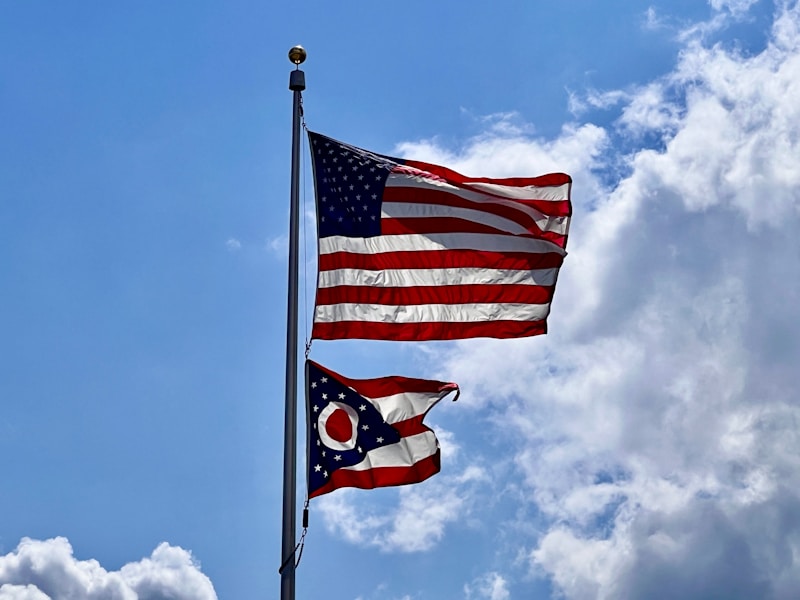Ohio voter advocates say gerrymandering robs voters of power, and fair maps mean more bipartisanship from lawmakers and district maps that are actually logical and representative.
Throughout the two years that Ohio spent watching the Ohio Redistricting Commission adopt and revise six Ohio Statehouse maps and two congressional maps, there were attempts to bring levity to the process.
One such attempt was naming the sometimes meandering, oftentimes abstract-looking districts that came about as part of the what the elected officials on the commission said was following the rules of compactness, population requirements and other legal determinants of redistricting.
In a new report released by the League of Women Voters of Ohio, the 1st congressional district in southwestern Ohio is described as an “angry elephant.”
But the idea that the districts are shaped in such a way as to leave room for artistic interpretation doesn’t spell fun times for voters, according to voting advocates and redistricting experts.
“In addition to diluting political power, this type of division makes it difficult for voters to know in which district they live, for whom they vote and who represents them,” the LWV report stated.
The criticisms came fast and swift as the districts were laid out by the ORC, and now that reform is on the ballot in November with Issue 1, the impact of these “odd-shaped, sprawling districts,” as Ohio’s League of Women Voters Executive Director Jen Miller described them, are laid bare for their flaws not only in representing voters, but also in allowing elected officials to respond to districts that in some cases are hundreds of miles wide.
“In gerrymandering, what we see across Ohio are neighborhoods, towns, villages, school districts, that are split purposefully to gain partisan outcome and to make sure that some politicians win over and over again,” Miller said. “In the process, they smush together voters who have different economic needs, social needs, and it can make a lawmaker struggle to meet the needs of their constituency.”
While changes that could be made in the proposed constitutional amendment would still, based on voting trends for the last 10 years, bring a slight Republican advantage to the state’s congressional delegation and the Statehouse, Miller said “we’ll see a lot of competitive seats which will swing one way or the other.”
That would result in more bipartisan policymaking, she said, and voters would hold more weight than in recent years where a Republican Statehouse supermajority did not include many competitive districts.
“Because whoever wins the primary will win that legislative seat in the general, a very small number of voters are deciding who will represent a much larger group of constituents,” Miller said.
Research conducted by Dr. David Niven, professor at the University of Cincinnati, was included in the LWV report, finding that Ohio’s congressional districts are “built on division – divided neighborhoods cut in dizzying ways and divided school districts cut into pieces.”
The village of Strasburg in Tuscarawas County was showcased for its distance from the congressional district office that represents it: 114 miles.
That long drive might be even more confusing for residents of the town, considering there are 12 other congressional district offices working for seven other districts in closer proximity to Strasburg, according to Niven’s research.
“Quality representation is facilitated by coherent districts drawn to serve the people and their common interests,” according to the LWV. “But the disparities, division and disadvantage seen here exact a cost to the health of the overall political system when accountability is compromised.”
With Issue 1 up in November, voters have a different way of engaging with that political system, a way that may be “less emotional” than, say, a presidential election, but “more lasting to institute a process reform,” according to Dr. Sam Wang, of the Princeton Gerrymandering Project at Princeton University, and founding director of the Electoral Innovation Lab.
While the process of redistricting was once considered a wonky topic, citizens are now “pretty sensitized to the issues,” Wang said, and voters can now be empowered to not only vote for the candidates they want in the next election, but potentially make sure that vote has further power.
“In certain instances, there can be opportunities to change how democracy works, and that can be through ballot initiatives,” Wang said. “Uniquely, this year, Ohioans have a chance to change the redistricting process itself.”
Ohioans have had the chance in the past, with the votes in 2015 and 2018 to reform the redistricting process, in legislature-led ballot initiatives that brought the Ohio Redistricting Commission and the process as it currently stands, but that doesn’t mean voters should shy away from doing it again.
“People are angry that politicians on the redistricting commission have not honored the letter of the law, and more importantly that getting reelected is their priority over fair representation and impartial district lines,” Miller said.
From Wang’s point of view, voters have to recognize that they are “in a relationship” with their government, which means being “ready to admit when things didn’t go right and when we should try again.”
In his years of study of national redistricting processes, he said a track record has been established that proves what methods have worked in various states, and what haven’t.
“Of all the experiments that have been done, the least contentious and most balanced process has come from an independent citizen commission with sole authority drawing maps,” Wang said.
Ohio Capital Journal is part of States Newsroom, a nonprofit news network supported by grants and a coalition of donors as a 501c(3) public charity. Ohio Capital Journal maintains editorial independence. Contact Editor David Dewitt for questions: [email protected]. Follow Ohio Capital Journal on Facebook and X.






